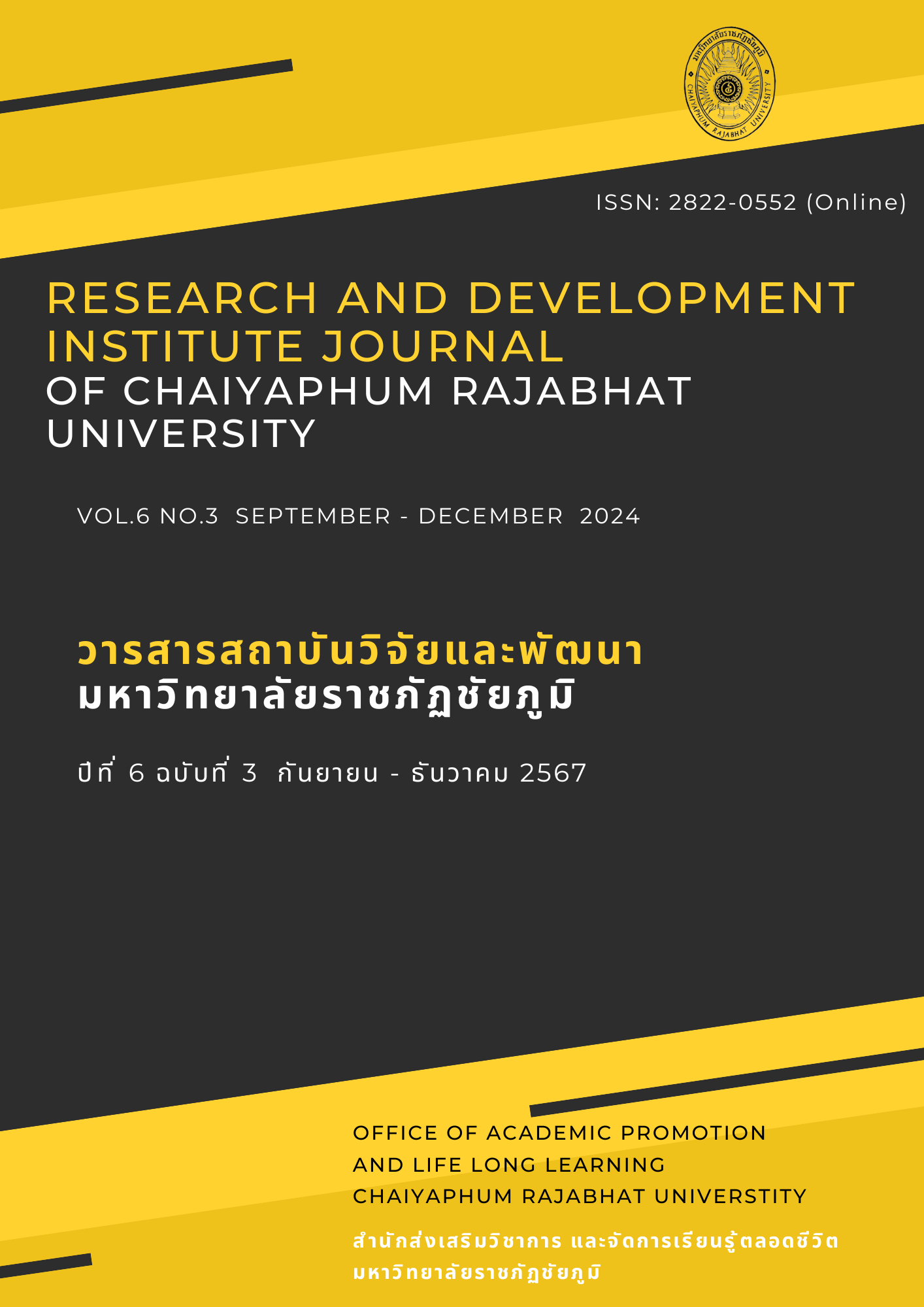A MODEL FOR DEVELOPING THE IMPLEMENTATION OF STANDARDS FOR EARLY CHILDHOOD DEVELOPMENT CENTERS UNDER LOCAL ADMINISTRATIVE ORGANIZATIONS IN THE LOWER NORTHEASTERN REGION 1 MODEL FOR DEVELOPING THE IMPLEMENTATION OF STANDARDS FOR EARLY CHILDHOOD DEVELOPMENT CENTERS UNDER LOCAL ADMINISTRATIVE ORGANIZATIONS IN THE LOWER NORTHEASTERN REGION 1
Main Article Content
Abstract
This research aimed 1) to study the current conditions and approaches for implementing the standards for Early Childhood Development Centers under Local Administrative Organizations in the Lower Northeastern Region 1, 2) to create a model implementing the standards for Early Childhood Development Centers under Local Administrative Organizations in the Lower Northeastern Region 1, and 3) to evaluate the feasibility and benefits of the model for developing the implementation of standards for Early Childhood Development Centers under Local Administrative Organizations in the Lower Northeastern Region 1. The research was conducted in three phases, namely, studying current conditions and approaches for implementing the standards for Early Childhood Development Centers under Local Administrative Organizations in the Lower Northeastern Region 1. The sample group consisted of 325 heads of educational institutions, child development centers in the academic year 2024. The instrument used was a five-level rating scale questionnaire, with an Item-Objective Congruence (IOC) index ranging from 0.60 to 1.00 and a reliability coefficient of 0.774. Data analysis included frequency, percentage, mean, and standard deviation. 2. Creating a development model for the operation according to the standards of the Child Development Center under Local Administrative Organization under Lower Northeastern Region 1, Step 1: The researcher used the study results from Part 1 to create (draft) according to the concept, theory, and model creation based on the components of the model, which are 1) principles and reasons of the model, 2) objectives of the model, 3) essential content and development implementation, 4) guidelines for implementing the model, and 5) conditions for model success. The results from the study of the operation according to the standards of the Child Development Center of the Local Administrative Organization in the Lower Northeastern Region 1, were used in all aspects, considering items with high average values that were necessary for development. Step 2: Interviewing experts to present a draft of the operational development model according to the standards of the Child Development Center of the Local Administrative Organization, Lower Northeast Region 1, with experts considering the appropriateness of the model and providing comments. Step 3: Evaluation of the appropriateness of the development model of the operation according to the standards of the Local Administrative Organization of the Child Development Center, the Lower Northeastern Region 1, to send to the experts to evaluate the appropriateness of the model. Analyze the appropriateness of the model using basic statistics, namely, the mean (M) and the standard deviation (SD) and interpret the results according to the specified criteria. Step 3: Evaluation of the feasibility and usefulness of the operation model according to the standards of the Child Development Center of the Local Administrative Organization, the Lower Northeastern Region 1. The data provider group was determined to be the head of the Child Development Center of the Local Administrative Organization, the Lower Northeastern Region 1, who were specifically selected (Purposive Selected), totaling 50 people. Data collection was performed, resulting in 46 sets of data, accounting for 92.00 percent. Data were analyzed using basic statistics, namely, the mean (M) and the standard deviation (SD) and interpreted according to the specified criteria.
Research findings were as follows:
1) The implementation of standards for Early Childhood Development Centers under Local Administrative Organizations in the Lower Northeastern Region 1, both overall and for individual aspects, was at the highest level.
2) The model for developing the implementation of standards for Early Childhood Development Centers under Local Administrative Organizations in the Lower Northeastern Region 1 consisted of five components: 1) principles and rationale, 2) objectives, 3) core content and development processes, 4) guidelines for implementation, and 5) conditions for success. The model's appropriateness was at the highest level.
3) The evaluation of the feasibility and benefits of the model for developing the implementation of standards for Early Childhood Development Centers under Local Administrative Organizations in the Lower Northeastern Region 1 was at the highest level
Article Details

This work is licensed under a Creative Commons Attribution-NonCommercial-NoDerivatives 4.0 International License.
Permission to use text, content, images, etc. of publication. Any user to read, download, copy, distribute, print, search, or link to the full texts of articles, crawl them for indexing, pass them as data to software, or use them for any other lawful purpose. But do not use it for commercial use or with the intent to benefit any business. Published under a Creative Commons Attribution-NonCommercial-NoDerivatives 4.0 International License.

This work is licensed under a Creative Commons Attribution-NonCommercial-NoDerivatives 4.0 International License
References
กรมส่งเสริมการปกครองส่วนท้องถิ่น กระทรวงมหาดไทย. (2559). มาตรฐานการดำเนินงานศูนย์พัฒนาเด็กเล็ก ขององค์กรปกครองส่วนท้องถิ่น. กรมส่งเสริมการปกครองท้องถิ่น.
กระทรวงศึกษาธิการ. (2562). มาตรฐานสถานพัฒนาเด็กปฐมวัยแห่งชาติ. สำนักมาตรฐานการศึกษาและพัฒนาการเรียนรู้.
บุญชม ศรีสะอาด. (2553). การวิจัยเบื้องต้น (พิมพ์ครั้งที่ 8). สุวีริยาสาสน์.
พระราชบัญญัติการศึกษาแห่งชาติ พ.ศ.2542. (19 สิงหาคม 2542). ราชกิจจานุเบกษา. เล่มที่ 116 ตอนที่ 74 ก, หน้า 1 - 23
พิมพ์เพ็ญ ยอดแก้ว. (2551). การพัฒนารูปแบบการจัดการศูนย์พัฒนาเด็กเล็กโดยการมีส่วนร่วมของชุมชนตำบลศรีวิชัย อำเภอลี้ จังหวัดลำพูน (รายงานการวิจัย). สำนักกองทุนสนับสนุนการวิจัย(สกว).
สุวิมล ว่องวานิช. (2549).ประเภท ขั้นตอนของการประเมินอภิมาน และคุณสมบัติของนักประเมินอภิมานในการประเมินอภิมาน วิธีวิทยาและการประยุกต์ใช้. จุฬาลงกรณ์มหาวิทยาลัย.
Gesell, A., Halverson, H. M., & Amatruda, C. S. (1940). The First Five Years of Life; A Guide to the Study of the Preschool Child. Harper and Brothers.
Keeves, P. J. (1988). Educational Research, Methodology and Measurement: An International Handbook. Pergamon Press.
Krejcie, R. V., & Morgan, D. W. (1970). Determining Sample Size for Research Activities. Educational and Psychological Measurement, 30(3), 607-610. https://doi.org/10.1177/001316447003000308

